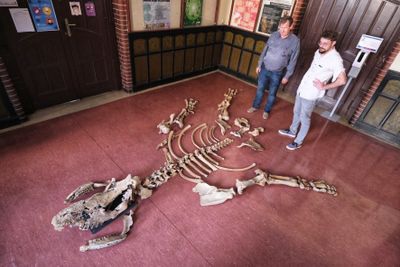In May 2016, a construction team in Poland was working on the initial stages of building a highway, when they stumbled across a skeleton. According to Dr Krzysztof Stefaniak from the University of Wrocław, “When the skeleton was first discovered, the builders initially wanted to throw it away[.]” Fortunately, “…there was a football match on and they left to watch it”, at which point, Dr. Stefaniak and a team of paleontologists stepped in and took over. Ever since, Dr. Stefaniak and others from the University of Wroclaw have been reconstructing the skeleton: originally thinking they’d found a wooly rhinoceros, the paleontological team soon discovered it was, in fact, the far less common Stephanorhinus, or Merck’s rhinoceros.

Thankfully, now that it has actually unearthed and recovered the specimen, the team doesn’t have to rely solely on traditional storage methods – or luck – to keep what it has found. They’ve also been using a 3D printer to backup their research, gradually printing the Merck’s rhinoceros, bone by bone, so that they’ll have a full copy of the skeleton in addition to the reconstructed original. The team is applying techniques that have been used for some time now to produce replicas of dinosaur skeletons. Recently, the same genre of 3D imaging tech has been used to create models of sauropod embryos by studying dinosaur egg fragments with high resolution 3D scanning and imaging software. And 3D printing involving rhinoceroses has frequently been in the news as well, usually involving attempts to replace poached ivory with AM alternatives.

For those of us who don’t have to worry about keeping a prehistoric rhinoceros skeleton intact: it may seem that, when you already have the original specimen – especially one in as unusually good shape as the one the team in Poland found – 3D printing a replica is just creating a lot of extra work for yourself. Why not just keep the original for yourself, and let everyone else who isn’t lucky enough to find one print out their own replicas? For one thing, as Dr. Stefaniak points out, “It is important to use [our specimen] to make the results of our research widely available.” The security of knowing that they have a 3D printed backup meant the team was happy to send a sample of their Merck’s rhinoceros’s teeth to the London Museum of Natural History for additional analysis, which has already paid dividends: based on their findings, the scientists in London, along with Dr. Stefaniak’s team, were able to improve their knowledge of the animal’s diet, which, in turn, led them to add to their understanding of Stephanorhinus’s habitat.
For another thing, as Dr. Stefaniak notes, climate change is rapidly altering the literal landscape that paleontologists use as a basis for their analyses. The more that continues, the more important it is, not only to preserve all existing findings, but to add to the repertoire of virtual imagining techniques to allow the study of the past to take place with as little future effect on the physical environment as possible. This is no small advantage, especially considering how important fossils are to all other aspects of studying the longest-term climate trends. That is, not only can 3D printing help scientists understand how humans have affected their surroundings, historically, but it can also, equally, help humans in general to have less of a detrimental impact in the present, in all the processes we’ve developed to learn about ourselves and our environment.

Subscribe to Our Email Newsletter
Stay up-to-date on all the latest news from the 3D printing industry and receive information and offers from third party vendors.
You May Also Like
3D Printing Financials: Fathom Struggles in Financial Quicksand During Critical Transition
Facing a year of key transitions and financial pressures, Fathom (Nasdaq: FTHM) has filed its annual report for 2023 with the U.S. Securities and Exchange Commission (SEC). The document outlines...
Latest Earnings Overview for Australian 3D Printing Firms Titomic and AML3D
Australian 3D printing manufacturing firms Titomic (ASX: TTT) and AML3D (ASX: AL3) reported their financial results for the period from July to December 2023, marking the first half of their...
3D Printing Webinar and Event Roundup: April 7, 2024
Webinars and events in the 3D printing industry are picking back up this week! Sea-Air-Space is coming to Maryland, and SAE International is sponsoring a 3D Systems webinar about 3D...
3D Printing Financials: Unpacking Farsoon and BLT’s 2023 Performance
In the Chinese 3D printing industry, two companies, Farsoon (SHA: 688433) and Bright Laser Technologies, or BLT (SHA: 688333), have recently unveiled their full-year earnings for 2023. Farsoon reported increases...































